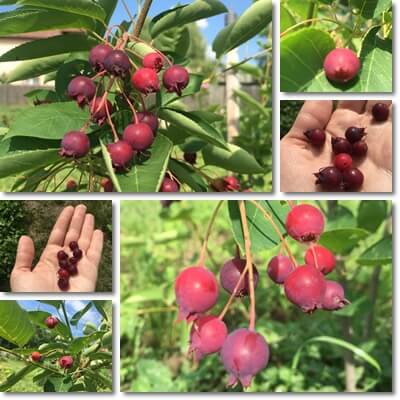Amelanchier berries are the sweetest, most flavorful fruit you can eat and, according to science, the second best antioxidant-rich fruit after aronia or chokeberry.
The Amelanchier goes by different names, each suggestive of a particular trait. It’s commonly referred to as serviceberry while the fruit are called serviceberries.
Amelanchier is also known as shadbush or shadwood because it blooms when shad fish reach the rivers and streams in Northern America (the name is based on the migration of the fish species). It’s also called juneberry because its edible fruit ripen in June. It may be referred to as sugar-plum or wild plum because it’s extremely sweet and has flavor notes similar to sweet, overly-ripe plums. Lastly, it goes by the name of saskatoon or Canadian serviceberry and, apparently, is the namesake of the Canadian city of Saskatoon.

What is Amelanchier?
The name Amelanchier denominates between 20 and 30+ related species of shrubs and small trees in the rose family that produce edible, blueberry-like fruits. The Amelanchier can be found throughout North America and Canada as well as Europe and Asia where it both occurs naturally in the wild and is cultivated as an ornamental plant. Most species produce edible berries with a pleasantly sweet taste and fruity flavors, good nutritional value and excellent antioxidant profile.
What do Amelanchier berries look like?
What do Amelanchier berries, serviceberries or juneberries look like? They look a lot like blueberries actually: small, rounded fruits with a small protuberance that looks sort of like a crown at the end opposite to the stalk. The skin of the unripe serviceberry or juneberry is light green, but changes color as it ripens.
The berries become good to eat as soon as their skin turns a deep red color, but are fully ripe when they turn dark purple. Also, the skin of the ripe fruit appears waxy. The flesh is translucent white, heavily tinged with red or purple from the skin and juicy. Each berry contains several, light brown, kidney-shaped and extremely small seeds.
Can you eat Amelanchier berries?
Are Amelanchier, serviceberries or juneberries edible for humans? Yes, they are. Most know species of the plant produce fruits that are edible both raw and cooked. You can eat the skin, pulp and seeds of serviceberries without any issues as they are all perfectly safe to eat. The berries are good to eat when they’ve yet to fully ripen and are a deep red or red-purple color, and when they’re fully ripe and are dark purple in color. Although they are called ‘berries’, the fruits are botanically ‘pomes’ like the apple, pear, quince, medlar, aronia or chokeberry.
What do Amelanchier berries taste like?
Not only are Amelanchier berries edible, but they are also absolutely delicious. Both the red-purple and dark purple fruit are juicy and extremely sweet, almost honey like. Serviceberries boast a varied aromatic profile and you can recognize plum, cherry plum (aka myrobalan plum), honeydew melon, pear, apple and even faint blueberry, raspberry or mango-like flavors.
Amelanchier seeds can easily be swallowed whole (they are so tiny you don’t even notice them). If crushed between the teeth, they reveal a bitter, almond-like taste. Overall, the berries are the most delicious fruit you can possibly eat, full of flavor and extremely sweet. Below is a collage of pictures I took of my 2-year old Amelanchier lamarckii shrub and its ripening berries, today, June 5th 2019.

What are the benefits of Amelanchier berries?
The health benefits of Amelanchier berries are a result of a good nutritional value and excellent antioxidant content. An wide range of essential vitamins and minerals such as vitamins A, C, E, B2, B5, B6, B7 and B9, calcium, copper, magnesium, iron, manganese, potassium, zinc, dietary fiber and antioxidant carotenes and especially anthocyanins contribute to the nutritional content of the berries and provide the basis for their health effects.
Read below what are the most notable nutrition facts and health benefits of Amelanchier berries.
1) Anti-aging, anti-inflammatory and antioxidant properties
These are owed to the excellent content of red and purple antioxidant anthocyanins in the ripe berries, notably cyanidin-3-O-galactoside and cyanidin-3-O-glucoside.
Anthocyanin and other flavonoid antioxidants in ripe, dark purple Amelanchier berries have been found to scavenge free radicals and prevent damage to cells both in in vitro and in vivo experiments, exerting anti-aging, anti-inflammatory, antioxidant and anticancer effects.
Various studies equate the antioxidant value of Amelanchier berries to that of blueberries or place them higher on the antioxidant scale, second to aronia or chokeberries.
2) Mild laxative effects
Amelanchier berries are about 20% dietary fiber. Dietary fiber adds bulk to stools which encourages peristaltic movements and relieves constipation.
Just as important, the berries contain a type of dietary fiber called pectin which can help bind loose stools and stop diarrhea. Lastly, pectin acts as a prebiotic, helping feed good gut bacteria populations for better digestive health.
3) Good for skin health and the nervous system
As little as 100 g of fresh, ripe Amelanchier berries provides between 275 and over 300% of the recommended daily intake of vitamin B2 for adult men and respectively women. The same amount provides about 66,66% of the recommended daily intake of biotin or vitamin B7, B8 or H for the average adult as well as modest amounts of vitamins B5, B6 and B9. B vitamins ensure the proper functioning of the nervous system and help maintain skin health.
4) Good to eat in pregnancy and for pregnant women
Excellent amounts of vitamin B2 play a role in preventing birth defects in babies as well as anemia in pregnant women. As a significant source of biotin, Amelanchier berries further support a healthy pregnancy, reducing deficiency risks. Small amounts of iron (around 1 mg per 100 g of fruits) combat low energy levels and fatigue associated with anemia and restore vitality, while dietary fiber (almost 6 g per 100 g of fruits with skin) combats constipation during pregnancy.
5) Low in calories but tonic and energizing
Amelanchier berries have only 85 kcal per 100 g, so they don’t promote weight gain when eaten in reasonable amounts, according to individual nutritional requirements. The ripe fruit are extremely sweet and contain a range of essential vitamins and minerals, from B vitamins to calcium, magnesium, potassium, phosphorus, manganese and iron, which hold benefits for metabolism, combat tiredness and restore good energy levels.
6) Other benefits of serviceberries
Eating Amelanchier may hold minor benefits for cardiovascular health, notably for blood pressure.
The ripe fruit has virtually no sodium, but contains small amounts of calcium, magnesium, potassium which help regulate blood pressure numbers and bring them down to normal levels.
Modest amounts of vitamin E (less than 10% of recommended daily intake) further contribute to cardiovascular benefits as well as benefits for skin.
The vitamin is integrated into cells where it exerts an antioxidant effect. Lastly, the generous amounts of dietary fiber together with magnesium exert a beneficial effect for blood sugar metabolism, helping prevent fluctuations and associated side effects.
